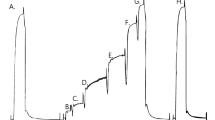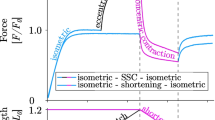Abstract
Human skeletal muscles consist of different fibre types: slow fibres (slow twitch or type I) containing the myosin heavy chain isoform (MHC)-I and fast fibres (fast twitch or type II) containing MHC-IIa (type IIA) or MHC-IId (type IID). The following order of decreasing kinetics is known: type IID > type IIA >> type I. This order is especially based on the kinetics of stretch activation, which is the most discriminative property among fibre types. In this study we tested if hybrid fibres containing both MHC-IIa and MHC-I (type C fibres) provide a transition in kinetics between fast (type IIA) and slow fibres (type I). Our data of stretch activation kinetics suggest that type C fibres, with different ratios of MHC-IIa and MHC-I, do not provide a continuous transition. Instead, a specialized group of slow fibres, which we called “transition fibres”, seems to provide a transition. Apart of their kinetics of stretch activation, which is most close to that of type IIA, the transition fibres are characterized by large cross-sectional areas and low maximal tensions. The molecular cause for the mechanical properties of the transition fibres is unknown. It is possible that the transition fibres contain an unknown slow MHC isoform, which cannot be separated by biochemical methods. Alternatively, or in addition, isoforms of myofibrillar proteins, other than MHC, and posttranslational modifications of myofibrillar proteins could play a role regarding the characteristics of the transition fibres.



Similar content being viewed by others
References
Andruchov O, Andruchova O, Wang Y, Galler S (2004) Kinetic properties of myosin heavy chain isoforms in mouse skeletal muscle: comparison with rat, rabbit, and human and correlation with amino acid sequence. Am J Physiol Cell Physiol 287:C1725–C1732
Andruchov O, Galler S (2008) Influence of fast and slow alkali myosin light chain isoforms on the kinetics of stretch-induced force transients of fast-twitch type IIA fibres of rat. Pflug Arch Eur J Phy 455:1165–1172
Andruchov O, Wang Y, Andruchova O, Galler S (2004) Functional properties of skinned rabbit skeletal and cardiac muscle preparations containing α-cardiac myosin heavy chain. Pflug Arch Eur J Phy 448:44–53
Bottinelli R (2001) Functional heterogeneity of mammalian single muscle fibres: do myosin isoforms tell the whole story? Pflug Arch Eur J Phy 443(1):6–17
Bottinelli R, Betto R, Schiaffino S, Reggiani C (1994) Unloaded shortening velocity and myosin heavy chain and alkali light chain isoform composition in rat skeletal muscle fibres. J Physiol (Lond) 478:341–349
D'Antona G, Megighian A, Bortolotto S, Pellegrino MA, Ragona RM, Staffieri A, Bottinelli R, Reggiani C (2002) Contractile properties and myosin heavy chain isoform composition in single fibre of human laryngeal muscles. J Muscle Res Cell Motil 23:187–195
Davis JS, Satorius CL, Epstein ND (2002) Kinetic effects of myosin regulatory light chain phosphorylation on skeletal muscle contraction. Biophys J 83:359–370
Fauteck SP, Kandarian SC (1995) Sensitive detection of myosin heavy chain composition in skeletal muscle under different loading conditions. Am J Physiol 268:C419–C424
Galler S, Hilber K (1994) Unloaded shortening of skinned mammalian skeletal muscle fibres. Effects of the experimental approach and passive force. J Muscle Res Cell Motil 15:400–412
Galler S, Hilber K, Gohlsch B, Pette D (1997) Two functionally distinct myosin heavy chain isoforms in slow skeletal muscle fibres. FEBS Lett 410:150–152
Galler S, Hilber K, Pette D (1997) Stretch activation and myosin heavy chain isoforms of rat, rabbit and human skeletal muscle fibres. J Muscle Res Cell Motil 18:441–448
Galler S, Schmitt TL, Pette D (1994) Stretch activation, unloaded shortening velocity, and myosin heavy chain isoforms of rat skeletal muscle fibres. J Physiol (Lond) 478:513–521
Hilber K, Galler S (1997) Mechanical properties and myosin heavy chain isoform composition of skinned skeletal muscle fibres from a human biopsy sample. Pflug Arch Eur J Phy 434(5):551–558
Hilber K, Galler S (1998) Improvement of the measurements on skinned muscle fibres by fixation of the fibre ends with glutaraldehyde. J Muscle Res Cell Motil 19:365–372
Hilber K, Galler S, Gohlsch B, Pette D (1999) Kinetic properties of myosin heavy chain isoforms in single fibers from human skeletal muscle. FEBS Letters 455:267–270
Maggs AM, Taylor-Harris P, Peckham M, Hughes SM (2000) Evidence for differential post-translational modifications of slow myosin heavy chain during murine skeletal muscle development. J Muscle Res Cell Motil 21:101–113
Mc Nally EM, Kraft R, Bravo-Zehnder M, Taylor DA, Leinwand LA (1989) Full-length rat alpha and beta cardiac myosin heavy chain sequences. Comparisons suggest a molecular basis for functional differences. J Mol Biol 210:665–671
O'Connell B, Stephenson DG, Blazev R, Stephenson GM (2004) Troponin C isoform composition determines differences in Sr2+-activation characteristics between rat diaphragm fibres. Am J Cell Physiol 287:79–87
Patterson MF, Stephenson DG, Kemp JG, Stephenson GM (2000) Ca2+-activation characteristics of single fibres from chemically skinned rat muscle incubated with glucose-6-phosphate. Pflug Arch Eur J Phy 439(6):845–852
Pette D, Staron RS (1990) Cellular and molecular diversities of mammalian skeletal muscle fibers. Rev Physiol Biochem Pharmacol 116:1–76
Ramamurthy B, Hook P, Jones AD, Larsson L (2001) Changes in myosin structure and function in response to glycation. FASEB J 15:2415–2422
Schiaffino S, Reggiani C (1996) Molecular diversity of myofibrillar proteins: gene regulation and functional significance. Physiol Rev 76:371–423
Stephenson GM (2001) Hybrid skeletal muscle fibres: a rare or common phenomenon? Clin Exp Pharmacol Physiol 28(8):692–702
Acknowledgments
We gratefully acknowledge the help of Tamara Elzenbaumer, Florian Kronbichler, Stefan Neunhäuserer, David Niederseer and Sandra Zensz.
Declaration
The authors declare that the experiments comply with the current laws of the country in which they were performed and that authors have no conflict of interest.
Author information
Authors and Affiliations
Corresponding author
Rights and permissions
About this article
Cite this article
Neunhäuserer, D., Zebedin, M., Obermoser, M. et al. Human skeletal muscle: transition between fast and slow fibre types. Pflugers Arch - Eur J Physiol 461, 537–543 (2011). https://doi.org/10.1007/s00424-011-0943-4
Received:
Revised:
Accepted:
Published:
Issue Date:
DOI: https://doi.org/10.1007/s00424-011-0943-4




